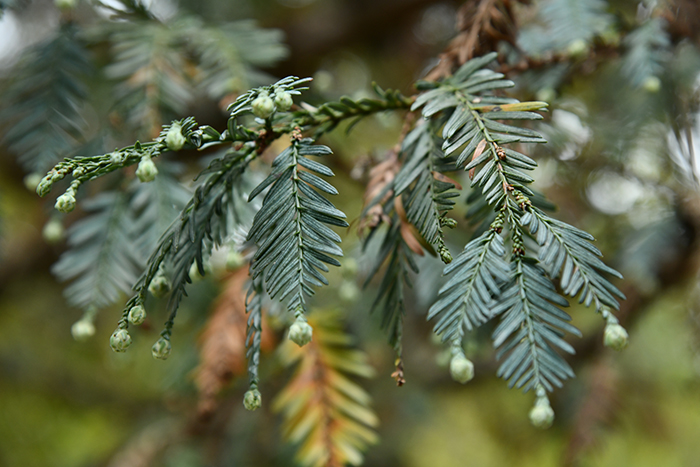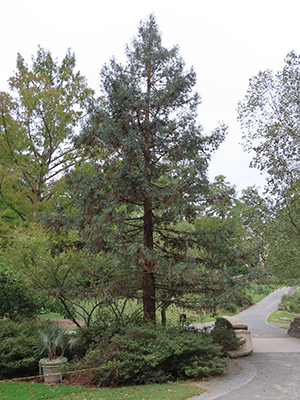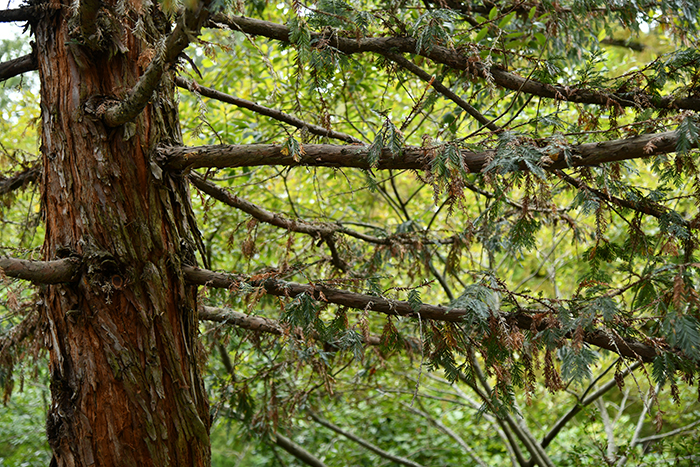Garden Talk

Botanical name: Sequoia sempervirens
Common name: Coast redwood
Family name: Cupressaceae (Cypress family)
Native range: Northern California coast
Location in Duke Gardens: Historic Gardens
USDA Hardiness Zones: 7-9
By Katherine Hale
Marketing & Communications Assistant

To say that coast redwoods (Sequioa sempervirens) inspire awe and wonder is a vast understatement: the groves at Muir Woods, Redwood National Park and other old-growth forests are living cathedrals, with each tree an entire ecosystem unto itself. This is a species full of superlatives—the tallest living organism in the world is a 380-foot coast redwood tree, they can grow 30 feet or more in diameter, and they are one of the longest-living species, standing for 2,000 years or more under ideal conditions.
Prior to the most recent Ice Age, coast redwoods were widespread across California as far south as Los Angeles. A rapidly changing climate pushed them back to a narrow strip of mountains and valleys along the Pacific Coast from San Francisco to the Oregon border, a region consistently shrouded by thick blankets of fog. Because transporting large quantities of water hundreds of feet into the air is a challenging hydraulics problem, the trees take advantage of the cool summers and high humidity by absorbing as much water as they can directly through their leaves.
Though they rarely reach their greatest heights outside the fog belt, coast redwoods are widely grown outside their native range throughout California and the Pacific Northwest, as well as farther afield. Unlike many California endemics, which cannot tolerate North Carolina’s hot and humid summers, selected cultivars of coast redwood do well here, including ‘Henderson Blue', notable for the distinct bluish cast to its foliage.
Wherever you are in the world, the biggest challenge to growing redwoods boils down to one simple statement: location, location, location. Because of this tree’s longevity and massive size, adequate spacing is essential to avoid conflicts decades down the road. As poet Jane Hirshfield wryly notes,
It is foolish
to let a young redwood
grow next to a house.Even in this
one lifetime,
you will have to choose.
Luckily for gardeners who are eager to have it all, many recent cultivars are naturally slow-growing, including the weeping ‘Kelly’s Prostrate’ and dwarf forms like ‘Yurok Prince’ and ‘Adpressa’. Other clever compromises include growing redwoods in pots to limit their growth or cultivating them as bonsai.
For those who wish to experience the majesty of a mature redwood without having to grow one themselves, the remaining wild groves in California are worth a pilgrimage at any time of year. Closer to home, there are two coast redwoods in the Historic Gardens. The ‘Henderson Blue’ cultivar is located by the Berini Bridge between the Butterfly Garden and the historic dawn redwood, and a wild-type Sequoia sempervirens is across the path from the pool in the South Lawn, along the border with Flowers Drive.
Photos from top: Close-up of coast redwood foliage, by William Hanley; 'Henderson Blue' coast redwood beside the Berini Bridge in the Historic Gardens, by Sue Lannon; close-up of coast redwood branches and bark, by William Hanley.






